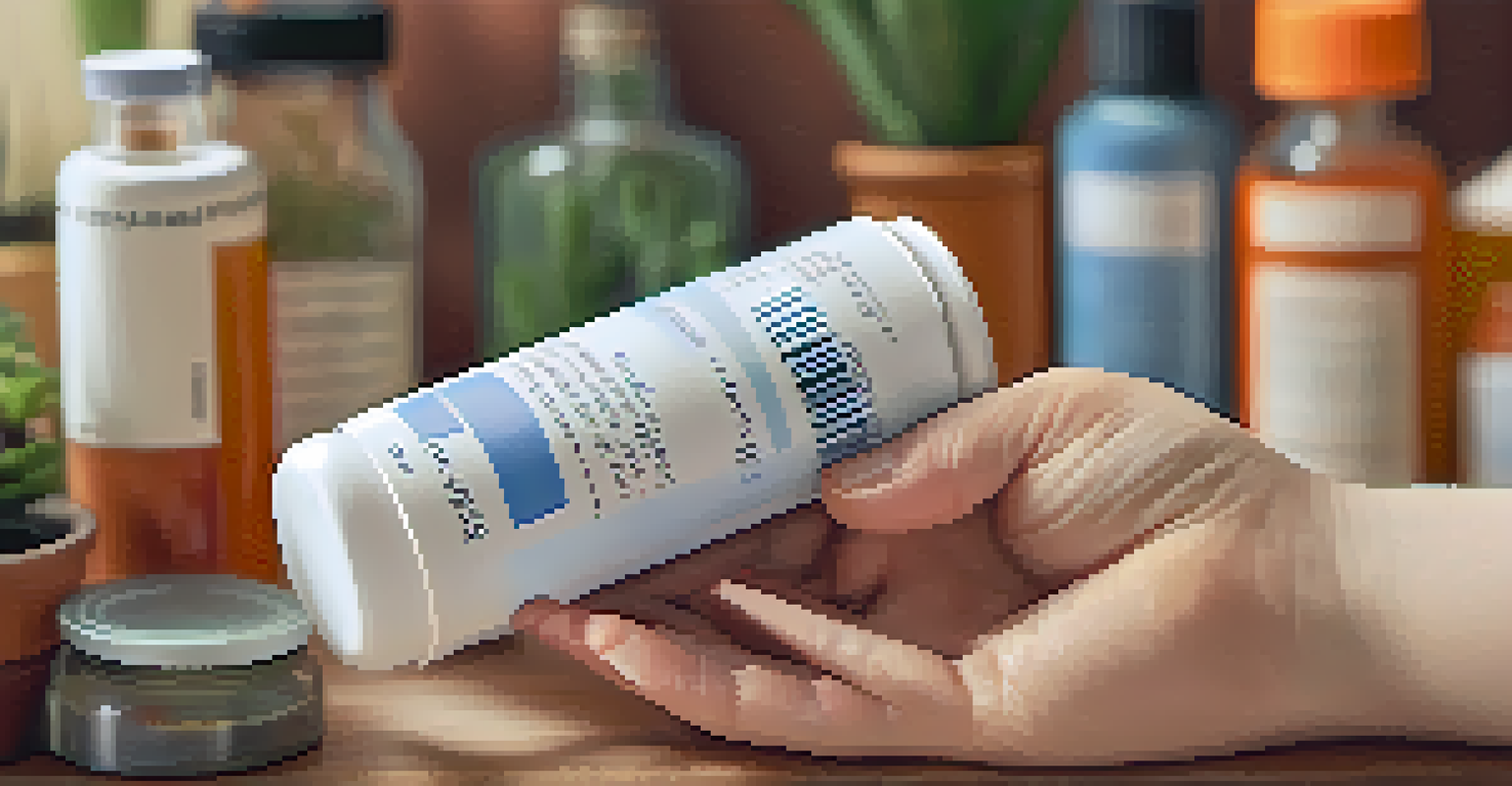Pharmacological Approaches to Treating Substance Use Disorders

Introduction to Substance Use Disorders and Treatment Options
Substance use disorders (SUDs) affect millions of individuals and their families, making effective treatment crucial. These disorders can manifest as addiction to alcohol, prescription medications, or illicit drugs, leading to significant health and social problems. Understanding the various treatment options available, particularly pharmacological approaches, is essential for fostering recovery and improving quality of life.
Addiction is a disease of the brain, but it is also a disease of relationships. Recovery is not just about stopping the use of substances; it is about rebuilding a life and reconnecting with the world.
Pharmacological treatments involve the use of medications to help manage withdrawal symptoms, reduce cravings, and support long-term recovery. While therapy and counseling play vital roles, medications can enhance these efforts and provide a more comprehensive treatment plan. This article explores key pharmacological strategies that have proven effective in treating SUDs.
Additionally, it's important to recognize that pharmacological approaches are not a one-size-fits-all solution. Each individual's experience with substance use is unique, and treatment should be tailored to their specific needs and circumstances. By combining medication with behavioral therapies, we can create a more robust support system for those in recovery.
Understanding Medications Used in SUD Treatment
Medications used to treat substance use disorders can be broadly categorized into three types: agonists, antagonists, and partial agonists. Agonists, like methadone and buprenorphine, activate the same receptors in the brain as the substances being abused, helping to alleviate cravings and withdrawal symptoms. On the other hand, antagonists, such as naltrexone, block these receptors, reducing the pleasurable effects of the substance.

Partial agonists, like buprenorphine, offer a middle ground, providing some activation of receptors while also blocking full activation by other substances. This balance helps to stabilize individuals in recovery without producing the full effects of the drug they are trying to avoid. Understanding these categories can help individuals and their families make informed decisions about treatment options.
Pharmacological Treatments Explained
Medications for substance use disorders can alleviate withdrawal symptoms, reduce cravings, and should be tailored to individual needs.
It's crucial to work with healthcare professionals to determine the most appropriate medication based on each person's unique situation. Factors such as the specific substance being abused, the severity of the disorder, and any co-occurring mental health conditions should all be considered.
Opioid Use Disorder and Medications for Treatment
Opioid use disorder (OUD) is one of the most pressing public health crises today, and effective pharmacological interventions are essential. Medications like methadone and buprenorphine have been widely used to treat OUD, offering a way to manage cravings and withdrawal symptoms. These medications can significantly reduce the risk of relapse and support individuals in leading healthier lives.
The greatest weapon against stress is our ability to choose one thought over another.
Methadone, a long-acting opioid agonist, is administered in a controlled setting and can help individuals transition away from more dangerous opioid use. Buprenorphine, a partial agonist, can be prescribed in outpatient settings, making it a more accessible option for many. Both treatments have been proven effective, but they must be combined with counseling and support for the best results.
Moreover, naltrexone is another medication that can aid in recovery from OUD by blocking the effects of opioids. It is important to note that naltrexone should be used after the individual has undergone detoxification to avoid withdrawal symptoms. Understanding these options can empower those affected by OUD and their loved ones to seek the appropriate treatment.
Alcohol Use Disorder and Pharmacological Treatments
Alcohol use disorder (AUD) is another common addiction that can significantly impact an individual's life. Medications such as disulfiram, acamprosate, and naltrexone have been developed to help manage AUD symptoms and support recovery efforts. Each of these medications works in different ways, allowing for a tailored approach based on individual needs.
Disulfiram, also known as Antabuse, creates an unpleasant reaction when alcohol is consumed, which can deter individuals from drinking. Acamprosate, on the other hand, helps to stabilize brain chemistry after detoxification and reduce cravings. Naltrexone can also be effective for AUD, as it decreases the pleasurable effects of alcohol consumption.
Importance of Behavioral Therapies
Combining medications with behavioral therapies enhances recovery by addressing both psychological and biological aspects of addiction.
Combining these medications with behavioral therapies provides a comprehensive treatment approach that can enhance recovery outcomes. Individuals struggling with AUD should consult with healthcare providers to explore the best pharmacological options for their specific circumstances.
Stimulant Use Disorder and Emerging Treatments
Stimulant use disorder, particularly related to cocaine and methamphetamine, poses unique treatment challenges. Currently, there are no FDA-approved medications specifically for stimulant use disorder, but research is ongoing to identify effective pharmacological interventions. Some promising candidates include bupropion and modafinil, which may help reduce cravings and withdrawal symptoms.
Bupropion, commonly used as an antidepressant, has shown potential in reducing cocaine cravings in some studies. Modafinil, a wakefulness-promoting agent, has also been explored for its ability to mitigate the impact of stimulant withdrawal. While these treatments are not yet standardized, they represent a hopeful direction for future pharmacological options.
As we continue to learn more about stimulant use disorder, it is essential to remain open to integrating new research findings into treatment plans. Collaborating with healthcare professionals can help individuals access the most current and effective options available.
The Role of Behavioral Therapies in Conjunction with Medications
While pharmacological treatments play a crucial role in managing substance use disorders, they are most effective when combined with behavioral therapies. These therapies, such as cognitive-behavioral therapy (CBT) and motivational interviewing, help individuals develop coping strategies and address the underlying issues related to their substance use. Together, medications and therapies create a holistic approach to recovery.
Behavioral therapies can enhance the effectiveness of medications by helping individuals understand their triggers and develop healthier habits. For example, CBT encourages self-reflection and problem-solving skills, empowering individuals to manage cravings and avoid relapse. By addressing both the biological and psychological aspects of addiction, we can improve treatment outcomes significantly.
Future Innovations in SUD Treatment
Ongoing research aims to develop new medications and personalized treatment strategies to improve outcomes for individuals with substance use disorders.
Moreover, ongoing support from family, friends, and healthcare providers is vital in maintaining recovery. Regular check-ins and support groups can further reinforce the lessons learned in therapy and provide encouragement during challenging times.
Future Directions in Pharmacological Treatments for SUDs
The landscape of pharmacological treatments for substance use disorders is constantly evolving as research continues to advance. Scientists are exploring new medications that target specific brain pathways affected by different substances, with the goal of improving efficacy and reducing side effects. This innovative approach may lead to more personalized treatment options in the future.
In addition to developing new medications, there is an increasing emphasis on integrating pharmacological and behavioral approaches for a more comprehensive treatment strategy. Personalized medicine, which tailors treatment to the individual's unique genetic and environmental factors, holds promise in improving outcomes for those with SUDs.

As we look ahead, it is crucial to continue advocating for research funding and access to effective treatments. By staying informed and open to new developments, we can better support individuals on their journey to recovery.